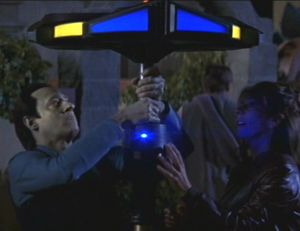Difference between revisions of "Transport inhibitor"
m (→See Also) |
|||
| (10 intermediate revisions by 2 users not shown) | |||
| Line 1: | Line 1: | ||
[[File:Transport Inhibitor.jpg|300px|thumb|right|A transport inhibitor being deployed by [[Data]].]] | |||
A '''transport inhibitor''' is a portable device that keeps people and objects in its area of effect from being "beamed up" by [[transporter]] systems. These devices figured prominently in the plot of ''[[Star Trek: Insurrection]]''. | A '''transport inhibitor''' is a portable device that keeps people and objects in its area of effect from being "beamed up" by [[transporter]] systems. These devices figured prominently in the plot of ''[[Star Trek: Insurrection]]''. | ||
The operational principles of transport inhibitors were not clearly explained, but they | The operational principles of transport inhibitors were not clearly explained, but they appear to prevent remote transporter systems from being able to "lock on" to targets in their vicinity. The villainous [[Son'a]] were eventually able to circumvent the problem by using drone vehicles to fire [[isolinear tag|tagging devices]] at their [[Ba'ku]] and [[Federation]] opponents; the tags provided a signal that the So'na transporters could lock onto in spite of the inhibitor fields, enabling them to transport their enemies to a holding facility. | ||
==Application to Combat Tactics== | ==Application to Combat Tactics== | ||
The existence of transport inhibitors may explain the [[boarding]] tactics used in ''Star Trek'' space battles. When enemy shields have been defeated, attackers always transport their own troops onto enemy vessels | The existence of transport inhibitors may explain the [[boarding]] tactics used in ''Star Trek'' space battles. When enemy shields have been defeated, attackers always transport their own troops onto enemy vessels and never transport enemies out of their ships. Transport inhibitor technology built into combat ships would explain this phenomenon: attackers would be unable to lock on to defenders due to the inhibitor fields, but the fields would not prevent them from inserting their own troops. Once on board the enemy vessel, invaders might need to find a way to disable the inhibitor fields before they could be retrieved, depending on whether the field is strong enough to prevent locking onto friendly personnel wearing [[communicator]]s. | ||
==See Also== | ==See Also== | ||
* [[Pattern enhancer]] | * [[Pattern enhancer]] | ||
* [[Transporter armband]] | |||
* [[Isolinear tag]] | |||
[[Category: Star Trek]] | |||
[[Category: ST Technology]] | |||
[[Category: ST Other Technology]] | [[Category: ST Other Technology]] | ||
Latest revision as of 18:54, 20 September 2022

A transport inhibitor is a portable device that keeps people and objects in its area of effect from being "beamed up" by transporter systems. These devices figured prominently in the plot of Star Trek: Insurrection.
The operational principles of transport inhibitors were not clearly explained, but they appear to prevent remote transporter systems from being able to "lock on" to targets in their vicinity. The villainous Son'a were eventually able to circumvent the problem by using drone vehicles to fire tagging devices at their Ba'ku and Federation opponents; the tags provided a signal that the So'na transporters could lock onto in spite of the inhibitor fields, enabling them to transport their enemies to a holding facility.
Application to Combat Tactics
The existence of transport inhibitors may explain the boarding tactics used in Star Trek space battles. When enemy shields have been defeated, attackers always transport their own troops onto enemy vessels and never transport enemies out of their ships. Transport inhibitor technology built into combat ships would explain this phenomenon: attackers would be unable to lock on to defenders due to the inhibitor fields, but the fields would not prevent them from inserting their own troops. Once on board the enemy vessel, invaders might need to find a way to disable the inhibitor fields before they could be retrieved, depending on whether the field is strong enough to prevent locking onto friendly personnel wearing communicators.